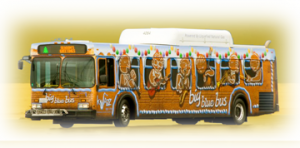As public transit agencies struggle with operating budget deficits while striving to provide vital transit service, transit agencies in California and Massachusetts are considering cutting-edge, on-board advertising to boost revenue.
 The California State Assembly recently passed a bill that would give the City of Santa Monica freedom to raise additional revenues through digital-electronic advertising on the sides of its Big Blue transit buses. To avoid distracting other drivers, the advertising boards would only be installed on the sidewalk-facing side of the Big Blue buses, and all advertisements would freeze while buses are on the freeway.
The California State Assembly recently passed a bill that would give the City of Santa Monica freedom to raise additional revenues through digital-electronic advertising on the sides of its Big Blue transit buses. To avoid distracting other drivers, the advertising boards would only be installed on the sidewalk-facing side of the Big Blue buses, and all advertisements would freeze while buses are on the freeway.
Digital billboards have come under scrutiny over the last 10 years. Opponents claim claiming that the constantly fluctuating and bright advertisements would cause accidents by distracting drivers. Studies to determine any negative effect from this media were inconclusive, but still under attack for funding coming from digital advertising companies.
Big Blue Bus marketing manager Dan Dawson says participating businesses would buy ad space in units ranging from 2.7 to 10 seconds, but not flash by so fast they come off as unreadable. He says the agency has not determined the duration of each digital posting.
Meanwhile in greater-Boston, the Massachusetts Bay Transit Authority (MBTA) has started to look for more innovative ways to help alleviate its $8.1 billion debt. General Manager Richard Davey says the MBTA has hit on the idea of selling audio advertising on the buses to ease the financial burden.
 Working with GPS technology tied into the onboard audio system, an ad would play for participating businesses as the bus passed by the location. Ohio-based Commuter Advertising has launched similar programs with several metropolitan transit authorities.
Working with GPS technology tied into the onboard audio system, an ad would play for participating businesses as the bus passed by the location. Ohio-based Commuter Advertising has launched similar programs with several metropolitan transit authorities.
Davey says while this concept is in the preliminary stages, the MBTA has tried similar strategies before. It launched T Radio in 2007, a mix of talk and music that played on platforms, but put the kibosh on the system before selling any ads.
Davey says this time MBTA would like to find a way to implement the ads without annoying riders.
As a means to securing more revenue, both agencies see these innovative programs as making economic sense.
Author of the California bill, Assemblywoman Julia Brownley (D- Santa Monica) says if this five-year pilot program works well in Santa Monica, transit agencies in other California cities could follow suit.
Dawson says agencies in Chicago, New York and London have already implemented this technology, and Big Blue Bus will be studying their standards, as these agencies have reported any increase in accidents as the result of the advertising program.
Big Blue Bus says it will hire a professional firm to study the matter further if the City Council chooses to allow the signs.
“If this bill passes the State Senate, it will still be another eight to 12 months before the digital ads begin to roll on the buses,” Dawson says. “The law is the first step in a long process to develop a marketing plan and a price structure.”
— David Hubbard

Thank god someone is getting creative rather than just raising my bus fare or my taxes.
Of course these make economic sense. This country is facing bad times. Go for it.
Sounds like an innovative idea indeed. And how cool would it be to get discounts from the advertisers that have ads play.